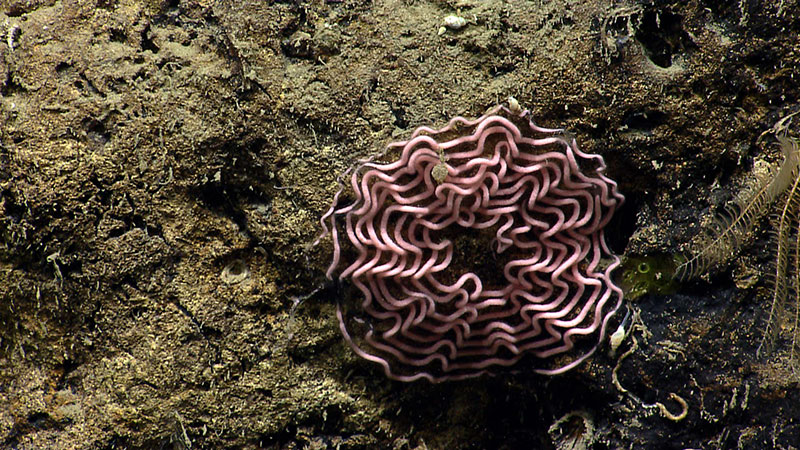Dive #6 at Nygren Canyon was very exciting. The remotely operated vehicle (ROV) was on bottom at 1325 UTC at a depth of 1,579 meters. While traversing over soft sediments, the seafloor was scattered with shell debris that transitioned to more abundant shell, coral skeleton, and small, dark rocks. Abundant organisms observed over or on the sediments included eels, xenophyophores, and brittle stars. There were a few sea pens and sea urchins also observed. The slope changed to more rugged topography, composed of dark, manganese encrusted rock. The hard substrate was populated by several taxa that have been documented previously on this expedition, including limid bivalves, stony corals, and sponges. On the rock surface, a coiled, pink mass resembling a gastropod egg mass was observed. At 1,558 meters, the rock face changed to a lighter color, consistent with carbonate, and multiple patches of mussels populated cracks within the rock. We had discovered a seep. Other organisms found within the mussel patches included serpulids, scaleworms, gastropods, and bacterial mats. Light, white fluffy material floated away from one of the mussel patches. Within five minutes, the ship was able to engage two seep experpts on shore to help us document the discovery. Several species of corals were documented throughout the dive, most of which occurred on the exposed rock face, but some were also found within the softer sediment at the beginning of the dive (e.g., sea pens). At least 17 octocoral species; three black coral species; three to four scleractinian species, including colonial (Solenosmilia) and solitary (cup corals, cf. Javania, Desmophyllum) forms; and three sea pens were noted. Other interesting observations were the first documentations of the black coral, Leiopathes, and a corallimorpharian for this expedition. An unusual sediment laden crab had its carapace decorated with a sponge. Dead coral skeleton provided a substrate for several species, including three species of corals, anemones, hydroids, barnacles, and crinoids. Other species associated with corals included squat lobsters on the black coral and bamboo coral and amphipods on other black corals. Large sponges with associated brittle stars and crinoids were found on the steep slope. The dive ended on steep feature composed of dark, manganese coated rock. The ROV was off bottom at 1945 UTC at a depth of 1,310 meters. After the ROV dive was completed, we conducted a CTC cast over the new seep site then conducted a couple hours of sonar mapping at the same location to make certain that we had well documented the unexpected seep site.
